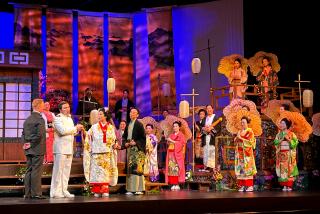‘Lonelyhearts’ kicks it up a notch
- Share via
Take a black comedy and make it darker. That’s what composer Lowell Liebermann, librettist J. D. McClatchy and director Ken Cazan did in turning Nathanael West’s 1933 novel, “Miss Lonelyhearts,” into an opera. In upping the ante, the team pushed a powerful commentary on Depression-era American society and its religious obsessions to grotesque proportions.
Commissioned for the centennial of the Juilliard School, where it premiered last year, “Miss Lonelyhearts” received its West Coast premiere Friday by the USC Thornton Opera in the Bing Theatre at USC.
The novel recounts a newspaper advice columnist’s descent into madness as he tries to respond to his letter writers’ desperate pleas for help. Increasingly mocked by a cynical editor and tormented by religious visions, he seeks escape in violence and sex and is killed at the end by the husband of a woman with whom he had a brief tryst.
McClatchy skillfully compressed the tight plot into a two-act opera of 10 scenes, but he also invented characters and actions and made changes in the story. Betty, Miss Lonelyhearts’ fiancee, for instance, doesn’t walk out on him in the end. Also, in the novel, the hapless, crippled Peter Doyle kills him accidentally while trying to escape from his mad, ecstatic embrace. In the opera, Doyle shoots him deliberately, multiple times.
This emphasis on excess is pervasive. In the book, Shrike, Miss Lonelyhearts’ editor, pens a nasty prayer (“Soul of Miss L., Glorify Me”). In the opera, he sings it -- dressed in a cardinal’s robe, no less. The novel has scenes of violence; the opera adds its own -- Shrike, for example, repeatedly shoving his knee into Doyle’s crippled leg.
Embodying the whole approach were ever-larger figures of the crucified Christ. Surely meant to signify Miss Lonelyhearts’ increasing delusions, they turned the opera more and more into a relentless screed.
Still, Liebermann’s eclectic score is effective -- moody in its opening, lovely in its tranquil nature-painting when Miss Lonelyhearts and Betty escape the city seeking regeneration in the country at the end of Act 1, and always illustrative.
Evaluation of its true value must wait for a cast of professionals, however. The USC students worked hard and diligently (there were two alternate casts in four scheduled performances over the weekend), but they were at various levels of accomplishment. Lyric baritone Rolando Sanz, as Doyle, perhaps gave the best hint of the score’s expressive possibilities.
The student orchestra conducted by Brent McMunn played strongly, though.
Peter Harrison designed the minimal but evocative sets, which included three large screens for filmed projections.
The USC Thornton School of Music and the Cincinnati College Conservatory of Music were collaborators with Juilliard in the creation of the work. (Cincinnati is set to get it in January.)
Liebermann, McClatchy and Cazan joined the cast for enthusiastic applause at the end.
More to Read
The biggest entertainment stories
Get our big stories about Hollywood, film, television, music, arts, culture and more right in your inbox as soon as they publish.
You may occasionally receive promotional content from the Los Angeles Times.










